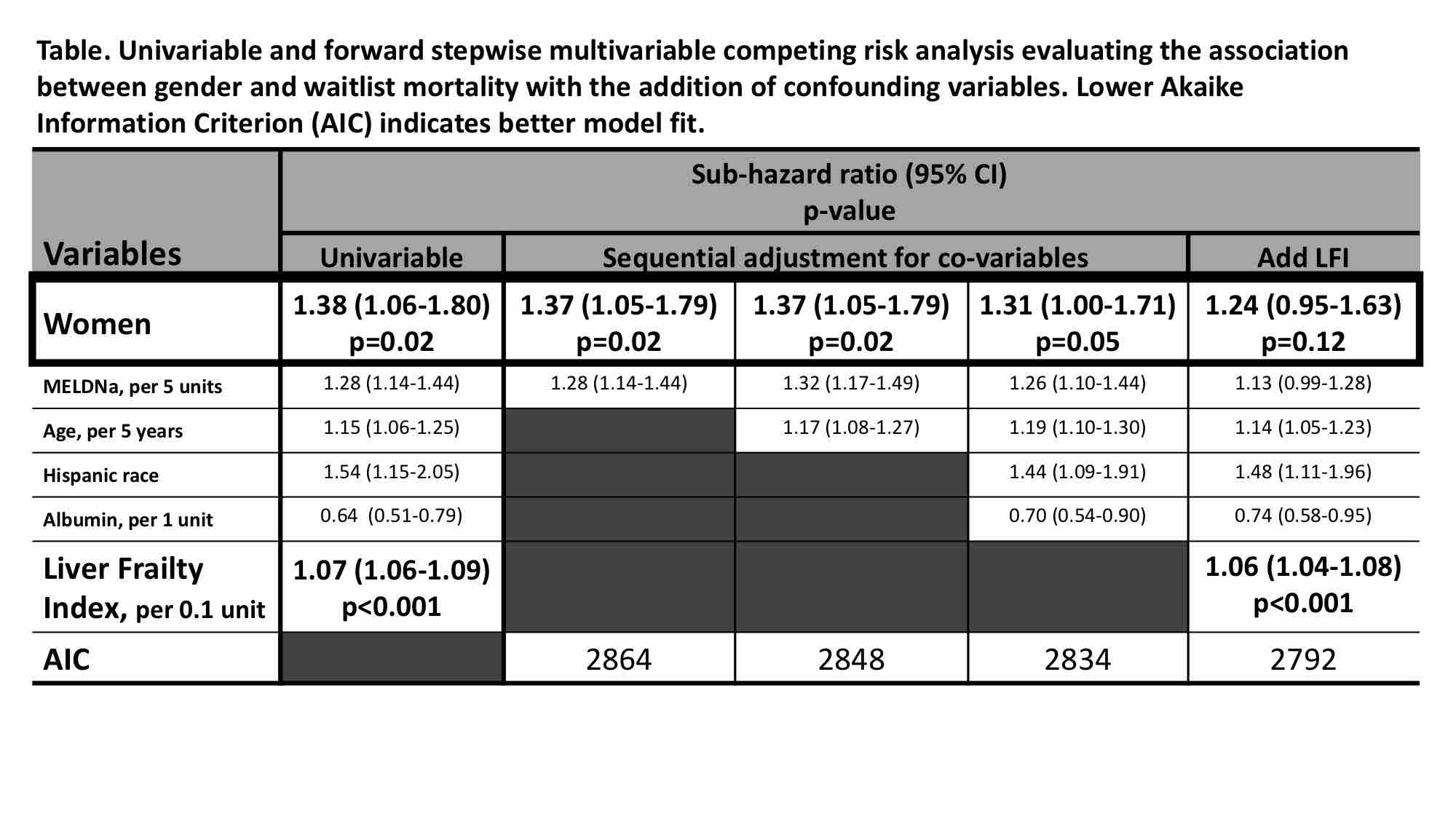Frailty Attenuates the Gender Gap in Waitlist Mortality in Liver Transplant Candidates: A Multi-Center Study with 1,240 Patients with Cirrhosis
1UCSF, San Francisco, CA, 2NW, Chicago, IL, 3Loma Linda Univ, Loma Linda, CA, 4UPMC, Pittsburgh, CA, 5UPMC, Pittsburgh, PA, 6Duke, Durham, NC, 7Baylor, Dallas, TX, 8JHMI, Baltimore, MD, 9Columbia, New York, NY
Meeting: 2020 American Transplant Congress
Abstract number: 643
Keywords: Liver cirrhosis, Risk factors, Survival, Waiting lists
Session Information
Session Time: 11:29am-12:13pm
 Presentation Time: 12:00pm-12:07pm
Presentation Time: 12:00pm-12:07pm
Location: Main Channel
*Purpose: Women LT candidates experience higher rates of waitlist mortality than men. Frailty is a critical determinant of mortality in patients with cirrhosis but it is unknown how frailty differs between women and men. Given known gender differences in muscle mass, we hypothesized that frailty is associated with the gender gap in waitlist mortality.
*Methods: Adults with cirrhosis awaiting LT without hepatocellular carcinoma at 8 LT centers were included. Frailty was assessed using the Liver Frailty Index (LFI; grip, chair stands, balance) at 3,214 clinic visits. Multilevel linear mixed-effects models evaluated the association between gender and frailty, accounting for fixed effects associated with frailty (age, MELDNa, ascites, and hepatic encephalopathy) and random effects (participant and follow-up time) to allow for differing baseline frailty and slope between patients. Competing risk regression (using LT as the competing risk) associated gender with waitlist mortality (=death/delisting for sickness) with sequential adjustments for covariates. Mediation analysis quantified the contribution of frailty to the mortality gender gap.
*Results: Of 1,240 participants, 505 (41%) were women. Women and men were similar by median MELDNa (19 v 18), but women had higher baseline LFI (4.0 v 3.9; p=0.02). Women displayed worse balance<30s (24 v 18%; p=0.009), and a trend toward worse gender-adjusted grip (-0.3 v -0.2; p=0.06) and chair stands/sec (0.36 v 0.38 p=0.08). In unadjusted mixed-effects models, LFI was 0.13 units higher in women than men. After adjustment for other variables associated with frailty, LFI was 0.14 units higher in women than men (p<0.001). In unadjusted regression, women experienced a 38% increased risk of waitlist mortality than men (95%CI 6-80%; p=0.02). Sequential adjustment for co-variables did not alter the association between gender and waitlist mortality; however, adjustment for LFI attenuated the mortality gender gap (Table). In mediation analysis, 18% of the mortality gender gap was mediated by frailty.
*Conclusions: Women with cirrhosis display worse frailty scores than men, despite similar MELDNa. We observed that the higher risk of waitlist mortality that women experienced on the waitlist was, in part, explained by frailty.
To cite this abstract in AMA style:
Lai JC, Ganger DR, Volk ML, Dodge JL, Dunn MA, Duarte-Rojo A, Kappus MR, Rahimi RS, Ladner D, Boyarsky B, McAdams-DeMarco M, Segev DL, McCulloch CE, Verna E. Frailty Attenuates the Gender Gap in Waitlist Mortality in Liver Transplant Candidates: A Multi-Center Study with 1,240 Patients with Cirrhosis [abstract]. Am J Transplant. 2020; 20 (suppl 3). https://atcmeetingabstracts.com/abstract/frailty-attenuates-the-gender-gap-in-waitlist-mortality-in-liver-transplant-candidates-a-multi-center-study-with-1240-patients-with-cirrhosis/. Accessed December 14, 2025.« Back to 2020 American Transplant Congress

